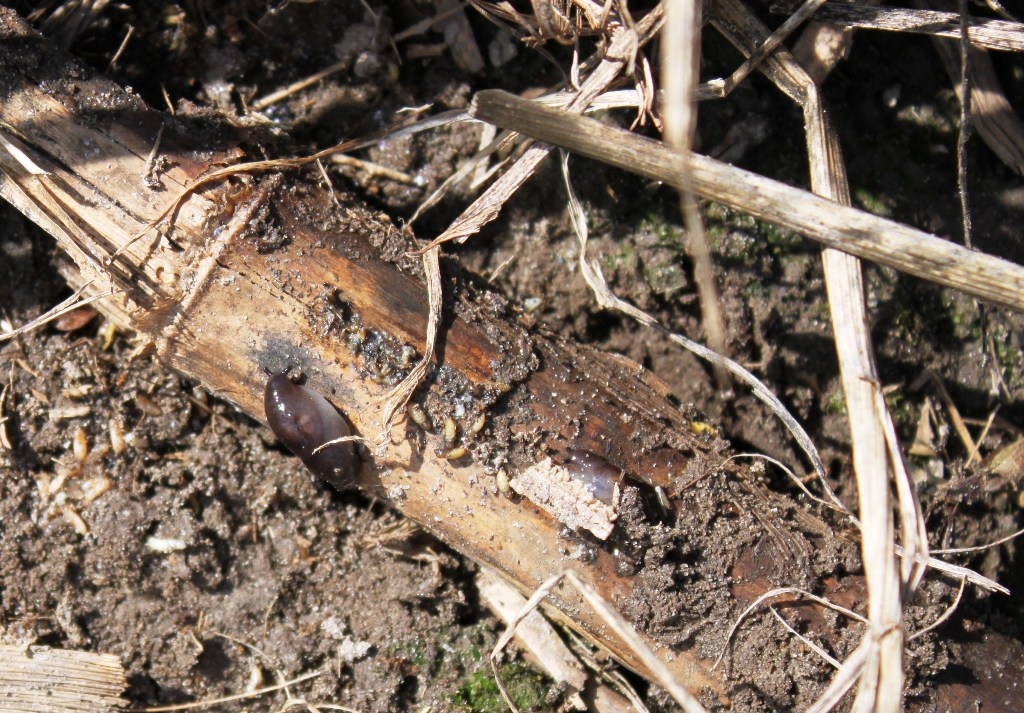I never expected to be writing an article on slugs in soybean in June , but this year is continuing to bring surprises. After a generally warm winter and spring, we’ve suddenly cooled off in the first week of June. And the slug activity in fields with a lot of residue has picked up. Usually, our slug problem disappears by the time warmer temperatures set in.
The photo  to the right was taken 5 days after planting soybean in a no-till field in Suffolk that contains lots of corn and rye cover crop residue. Stand was only about half of what was expected and feeding scars could be seen on the hypocotyl and cotyledons. When I dug in the seed furrow, I found slugs more often than not. Since it was a cloudy afternoon when I was in the field,
to the right was taken 5 days after planting soybean in a no-till field in Suffolk that contains lots of corn and rye cover crop residue. Stand was only about half of what was expected and feeding scars could be seen on the hypocotyl and cotyledons. When I dug in the seed furrow, I found slugs more often than not. Since it was a cloudy afternoon when I was in the field, I even found slugs feeding on soybean plants that were still partially covered by residue (slugs usually only feed at night). In an adjacent field that had not yet been planted, I found slugs on the underside of corn residue.
I even found slugs feeding on soybean plants that were still partially covered by residue (slugs usually only feed at night). In an adjacent field that had not yet been planted, I found slugs on the underside of corn residue.
 Will the soybean crop survive this late-season infestation? If the crop has emerged and has a couple of leaves on it, I’d say it will. But if you’re just planted or are now planting soybean and you’re finding slugs, I’d suggest using slug bait/molluscicide. The only one available (other than in small packages in home improvement/gardening stores) is Deadline®, which contains the active ingredient, metaldehyde. It is sold at Deadline®M-Ps™ Mini-Pellets (colored with a blue dye) and Deadline®Bullets (dye-free).
Will the soybean crop survive this late-season infestation? If the crop has emerged and has a couple of leaves on it, I’d say it will. But if you’re just planted or are now planting soybean and you’re finding slugs, I’d suggest using slug bait/molluscicide. The only one available (other than in small packages in home improvement/gardening stores) is Deadline®, which contains the active ingredient, metaldehyde. It is sold at Deadline®M-Ps™ Mini-Pellets (colored with a blue dye) and Deadline®Bullets (dye-free).
What if you have damage and are considering replanting? Usually, severe damage is only in part of a field, usually wetter areas. If this is the case and the damage is severe, you may want to consider replanted these areas. But if it’s the entire field, I’d suggest evaluating the stand of undamaged or slightly-damaged plants, and then following my guidelines for replanted poor stands (in this issue).
For more info, see Purdue Univ. website:
http://extension.entm.purdue.edu/fieldcropsipm/insects/soybean-slugs.php or
Ohio State’s pub, Slugs on Field Crops at
